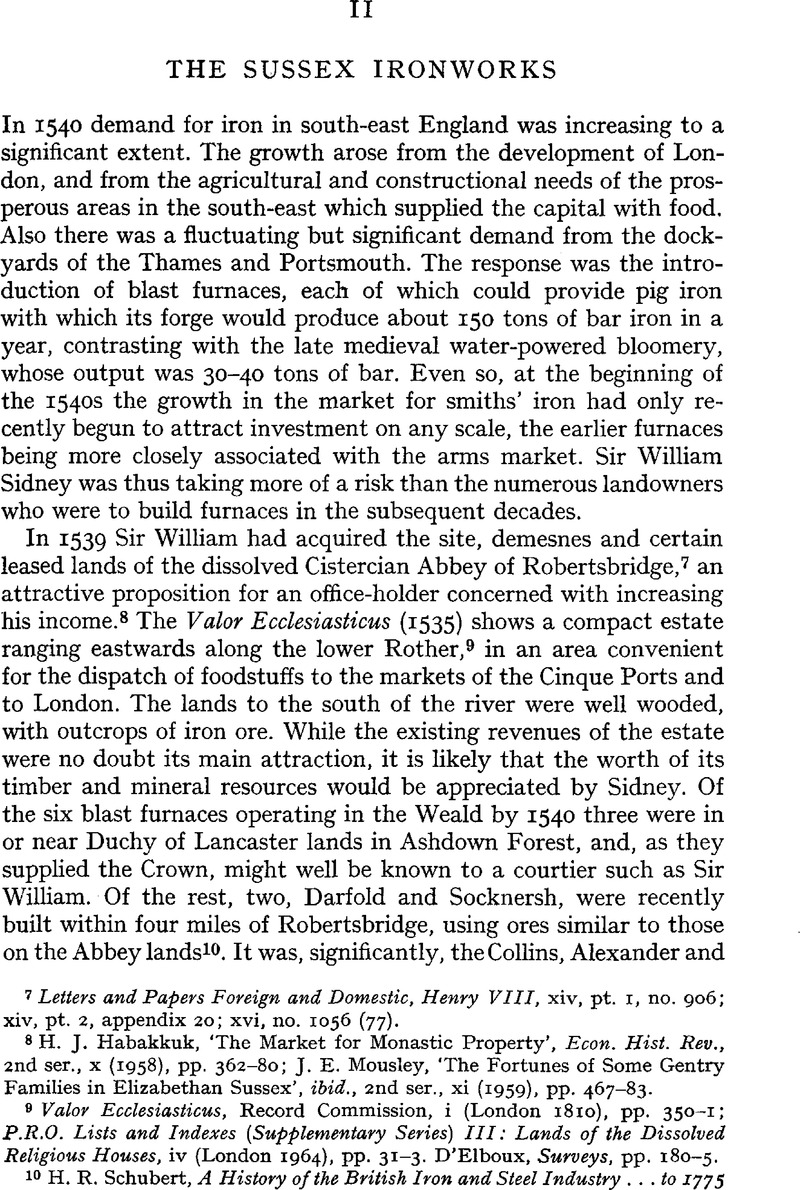No CrossRef data available.
Article contents
II The Sussex Ironworks
Published online by Cambridge University Press: 21 December 2009
Abstract

- Type
- Introduction
- Information
- Copyright
- Copyright © Royal Historical Society 1975
References
page 5 note 7 Letters and Papers Foreign and Domestic, Henry VIII, xiv, pt. 1, no. 906; xiv, pt. 2, appendix 20; xvi, no. 1056 (77).
page 5 note 8 Habakkuk, H. J., ‘The Market for Monastic Property’, Econ. Hist. Rev., 2nd ser., x (1958), pp. 362–80Google Scholar; Mousley, J. E., ‘The Fortunes of Some Gentry Families in Elizabethan Sussex’Google Scholar, ibid., 2nd ser., xi (1959), pp. 467–83.
page 5 note 9 Valor Ecclesiasticus, Record Commission, i (London 1810), pp. 350–1Google Scholar; P.R.O. Lists and Indexes (Supplementary Series) III: Lands of the Dissolved Religious Houses, iv (London 1964), pp. 31–3Google Scholar. D'Elboux, , Surveys, pp. 180–5.Google Scholar
page 5 note 10 Schubert, H. R., A History of the British Iron and Steel Industry … to 1775 (London 1957), Appendix vi passim. (Subsequently cited as ‘Schubert, History').Google Scholar
page 6 note 11 For Alexander Collins's later activities see Tudor Economic Documents Tawney, R. H. and Power, E., ed. (London 1924), i, pp. 237–8.Google Scholar
page 6 note 12 A single undated sheet (U 1475 E 54/1) in the collection at Maidstone, an item which seems never to have been noted in the Historical Manuscripts Commission Calendar, is worth mentioning. As it refers to Westall and ‘the vicar’ (Horrocke) it may well have been written by John Hawes, Sir William's steward. It comprises a list of reminders of enquiries to be made at Roberts-bridge, which include ‘to see what Cattell Remayneth of the olde stock’ and instructions over viewing ‘all the woods ther’. While it gives the impression of an early stock-taking under new ownership it seems that the furnace works had already been started—‘to shewe westall that the vycare dothe charge hym with viii11 more the was spoken of at his beynge here which he payed for Mynynge’; ‘to speke of the settynge of the flasshe over the furnesse pownde’.
page 8 note 13 The Barbam forge at Brooklands, south of Frant, is an example of direct continuity between bloomery and finery forges, Kent Archives Office, Maidstone, U 840/T 109; Straker, E., Wealden Iron (London 1931), p. 278Google Scholar. At Chingley, Lamberhurst, a 14th-century powered bloomery site was re-used in the 1580s, after at least 200 years of abandonment (n. 17, below). There is no reason to think an agreement of 1396 (U 1475/E 57) allowing the construction of a mill race on land between the Abbey and Bodiam had anything to do with an ironworks.
page 8 note 14 East Sussex Record Office, Battle Abbey MSS. 4435.
page 9 note 15 P.R.O. Patent Rolls, Elizabeth, 1103: this inventory for St. Leonards Forge, Sussex, is printed in Schubert, History, p. 400.Google Scholar
page 9 note 16 Agricola, surprisingly, only illustrates one complete water-powered hammer; a tail-helve. Agricola, G., De Re Metallica, (Basle, 1555)Google Scholar, ed. H. and L. Hoover (New York 1950), p. 422. Biringuccio, De Pirotechnia (Venice, 1540–1549)Google Scholar, completely neglects forge hammers.
page 9 note 17 Crossley, D. W., ‘The Ironworks of the Bewl Valley, Kent’Google Scholar, Royal Archaeological Institute, Monograph Series, forthcoming.
page 10 note 18 This (U 1475 E20/1) is a useful list of the Robertsbridge demesne lands, containing references to many of the woodlands whence charcoal came to the forge. With it should be placed E 20/2, a List of the Sussex Woods of the estate, of much the same period, indicating which were ‘appointed to the yron forge’. This, with the Battle Abbey material (n. 14 above) has been of great assistance in compiling Fig. 2. See also D'Elboux, Surveys, esp. pp. 1243.Google Scholar
page 10 note 19 Crossley, D. W., ‘A Sixteenth-century Wealden Blast Furnace: a Report on Excavations at Panningridge, Sussex, 1964–70’, Post-Medieval Archaeology vi (1972), pp. 42–68.CrossRefGoogle Scholar
page 10 note 20 For example: Herri met de Bles, ‘Landscape with Ironworks’, collection of the Prince of Liechtenstein, in Johannsen, O., Geschichte des Eisens [Dusseldorf 1953], opp. p. 144Google Scholar; Bles, ‘Landscape with. Ironworks and Mines’ (Uffizi Gallery, Florence) in Schubert, History, frontispiece; Lucas van Valkenborch, ‘Rocky Landscape with Huntsman’, (Herzog-Anton-Ulrich Museum, Brunswick) in Bernt, W., The Netherlandish Paintings of the Seventeenth Century (1970)Google Scholar, pl. 1217.
page 10 note 21 373, [2].
page 10 note 22 p. 43–7 below.




